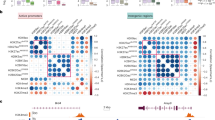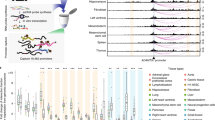Abstract
Eukaryotic gene transcription is accompanied by acetylation and methylation of nucleosomes near promoters, but the locations and roles of histone modifications elsewhere in the genome remain unclear. We determined the chromatin modification states in high resolution along 30 Mb of the human genome and found that active promoters are marked by trimethylation of Lys4 of histone H3 (H3K4), whereas enhancers are marked by monomethylation, but not trimethylation, of H3K4. We developed computational algorithms using these distinct chromatin signatures to identify new regulatory elements, predicting over 200 promoters and 400 enhancers within the 30-Mb region. This approach accurately predicted the location and function of independently identified regulatory elements with high sensitivity and specificity and uncovered a novel functional enhancer for the carnitine transporter SLC22A5 (OCTN2). Our results give insight into the connections between chromatin modifications and transcriptional regulatory activity and provide a new tool for the functional annotation of the human genome.
This is a preview of subscription content, access via your institution
Access options
Subscribe to this journal
Receive 12 print issues and online access
$209.00 per year
only $17.42 per issue
Buy this article
- Purchase on Springer Link
- Instant access to full article PDF
Prices may be subject to local taxes which are calculated during checkout





Similar content being viewed by others
Accession codes
References
Lemon, B. & Tjian, R. Orchestrated response: a symphony of transcription factors for gene control. Genes Dev. 14, 2551–2569 (2000).
Orphanides, G. & Reinberg, D. A unified theory of gene expression. Cell 108, 439–451 (2002).
Nightingale, K.P., O'Neill, L.P. & Turner, B.M. Histone modifications: signalling receptors and potential elements of a heritable epigenetic code. Curr. Opin. Genet. Dev. 16, 125–136 (2006).
Smale, S.T. & Kadonaga, J.T. The RNA polymerase II core promoter. Annu. Rev. Biochem. 72, 449–479 (2003).
Blackwood, E.M. & Kadonaga, J.T. Going the distance: a current view of enhancer action. Science 281, 60–63 (1998).
Bulger, M. & Groudine, M. Looping versus linking: toward a model for long-distance gene activation. Genes Dev. 13, 2465–2477 (1999).
Strahl, B.D. & Allis, C.D. The language of covalent histone modifications. Nature 403, 41–45 (2000).
Margueron, R., Trojer, P. & Reinberg, D. The key to development: interpreting the histone code? Curr. Opin. Genet. Dev. 15, 163–176 (2005).
Barrera, L.O. & Ren, B. The transcriptional regulatory code of eukaryotic cells - insights from genome-wide analysis of chromatin organization and transcription factor binding. Curr. Opin. Cell. Biol. 18, 291–298 (2006).
Hatzis, P. & Talianidis, I. Dynamics of enhancer-promoter communication during differentiation-induced gene activation. Mol. Cell 10, 1467–1477 (2002).
Wang, Q., Carroll, J.S. & Brown, M. Spatial and temporal recruitment of androgen receptor and its coactivators involves chromosomal looping and polymerase tracking. Mol. Cell 19, 631–642 (2005).
Bernstein, B.E. et al. Genomic maps and comparative analysis of histone modifications in human and mouse. Cell 120, 169–181 (2005).
Roh, T.Y., Cuddapah, S. & Zhao, K. Active chromatin domains are defined by acetylation islands revealed by genome-wide mapping. Genes Dev. 19, 542–552 (2005).
Kim, T.H. & Ren, B. Genome-wide analysis of protein-DNA interactions. Annu. Rev. Genomics Hum. Genet. 7, 81–102 (2006).
The ENCODE Project Consortium. The ENCODE (ENCyclopedia Of DNA Elements) Project. Science 306, 636–640 (2004).
Horvai, A.E. et al. Nuclear integration of JAK/STAT and Ras/AP-1 signaling by CBP and p300. Proc. Natl. Acad. Sci. USA 94, 1074–1079 (1997).
Pokholok, D.K. et al. Genome-wide map of nucleosome acetylation and methylation in yeast. Cell 122, 517–527 (2005).
Kim, T.H. et al. A high-resolution map of active promoters in the human genome. Nature 436, 876–880 (2005).
Pruitt, K.D., Tatusova, T. & Maglott, D.R. NCBI Reference Sequence (RefSeq): a curated non-redundant sequence database of genomes, transcripts and proteins. Nucleic Acids Res. 33, D501–D504 (2005).
Kouskouti, A. & Talianidis, I. Histone modifications defining active genes persist after transcriptional and mitotic inactivation. EMBO J. 24, 347–357 (2005).
Liu, C.L. et al. Single-nucleosome mapping of histone modifications in S. cerevisiae. PLoS Biol. 3, e328 (2005).
Harrow, J. et al. GENCODE: producing a reference annotation for ENCODE. Genome Biol. 7 (Suppl.), S4.1–S4.9 (2006).
Felsenfeld, G. Chromatin unfolds. Cell 86, 13–19 (1996).
Crawford, G.E. et al. DNase-chip: a high-resolution method to identify DNase I hypersensitive sites using tiled microarrays. Nat. Methods 3, 503–509 (2006).
Blanchette, M. et al. Genome-wide computational prediction of transcriptional regulatory modules reveals new insights into human gene expression. Genome Res. 16, 656–668 (2006).
Carninci, P. et al. Genome-wide analysis of mammalian promoter architecture and evolution. Nat. Genet. 38, 626–635 (2006).
Li, Q., Peterson, K.R., Fang, X. & Stamatoyannopoulos, G. Locus control regions. Blood 100, 3077–3086 (2002).
Schomig, E. et al. Molecular cloning and characterization of two novel transport proteins from rat kidney. FEBS Lett. 425, 79–86 (1998).
Sekine, T. et al. Molecular cloning and characterization of high-affinity carnitine transporter from rat intestine. Biochem. Biophys. Res. Commun. 251, 586–591 (1998).
Tamai, I. et al. Molecular and functional identification of sodium ion-dependent, high affinity human carnitine transporter OCTN2. J. Biol. Chem. 273, 20378–20382 (1998).
Wu, X., Prasad, P.D., Leibach, F.H. & Ganapathy, V. cDNA sequence, transport function, and genomic organization of human OCTN2, a new member of the organic cation transporter family. Biochem. Biophys. Res. Commun. 246, 589–595 (1998).
Nezu, J. et al. Primary systemic carnitine deficiency is caused by mutations in a gene encoding sodium ion-dependent carnitine transporter. Nat. Genet. 21, 91–94 (1999).
Shoji, Y. et al. Evidence for linkage of human primary systemic carnitine deficiency with D5S436: a novel gene locus on chromosome 5q. Am. J. Hum. Genet. 63, 101–108 (1998).
Stanley, C.A. Carnitine deficiency disorders in children. Ann. NY Acad. Sci. 1033, 42–51 (2004).
Wang, Y., Ye, J., Ganapathy, V. & Longo, N. Mutations in the organic cation/carnitine transporter OCTN2 in primary carnitine deficiency. Proc. Natl. Acad. Sci. USA 96, 2356–2360 (1999).
Acknowledgements
We thank J. Kadonaga, X. Fu and members of the Ren lab for comments. This work was supported by funding from the Ludwig Institute for Cancer Research (B.R.), the National Human Genome Research Institute (B.R., Z.W. and R.D.G.) and the National Cancer Institute (B.R.). Requests for materials should be addressed to B.R.
Author information
Authors and Affiliations
Contributions
N.D.H., B.R. and R.D.G. designed the transcription factor and histone ChIP-chip experiments; G.E.C. designed and performed the DNase-chip experiments; N.D.H., R.K.S., C.W.C., R.D.H. and S.V.C. conducted the ChIP-chip experiments; N.D.H., G.H., L.O.B., K.A.C. and C.Q. analyzed the microarray data; G.H., N.D.H., B.R. and W.W. conceived and developed the promoter and enhancer prediction method. Independently, Y.F. and Z.W. discovered the promoter-associated chromatin signatures. N.D.H. and B.R. wrote the manuscript.
Corresponding author
Ethics declarations
Competing interests
R.D.G. is an employee of NimbleGen Systems, Inc.
Supplementary information
Supplementary Fig. 1
ChIP-chip profiles at a representative promoter. (PDF 336 kb)
Supplementary Fig. 2
Cluster analysis in IFNγ-treated HeLa cells. (PDF 600 kb)
Supplementary Fig. 3
p300 binding distribution and DNaseI hypersensitivity. (PDF 330 kb)
Supplementary Fig. 4
Distribution of predicted enhancers in IFNγ-treated HeLa cells. (PDF 293 kb)
Supplementary Fig. 5
Prediction of a known enhancer, HS2, in the human β-globin locus. (PDF 371 kb)
Supplementary Fig. 6
Cross-validation of optimal histone modifications for prediction model. (PDF 362 kb)
Supplementary Table 1
Summary of RNAP ChIP-chip validation. (XLS 32 kb)
Supplementary Table 2
TSS classes from promoter clustering. (XLS 101 kb)
Supplementary Table 3
p300 binding sites. (XLS 69 kb)
Supplementary Table 4
DNaseI hypersensitive sites. (XLS 109 kb)
Supplementary Table 5
High-confidence prediction sets. (XLS 388 kb)
Supplementary Table 6
TRAP220 binding sites. (XLS 36 kb)
Supplementary Table 7
STAT1 binding sites. (XLS 24 kb)
Rights and permissions
About this article
Cite this article
Heintzman, N., Stuart, R., Hon, G. et al. Distinct and predictive chromatin signatures of transcriptional promoters and enhancers in the human genome. Nat Genet 39, 311–318 (2007). https://doi.org/10.1038/ng1966
Received:
Accepted:
Published:
Issue Date:
DOI: https://doi.org/10.1038/ng1966
This article is cited by
-
Impaired bone morphogenetic protein (BMP) signaling pathways disrupt decidualization in endometriosis
Communications Biology (2024)
-
Dynamic and distinct histone modifications facilitate human trophoblast lineage differentiation
Scientific Reports (2024)
-
Identification of Regulatory Elements in Primary Sensory Neurons Involved in Trauma-Induced Neuropathic Pain
Molecular Neurobiology (2024)
-
Inhibition of EHMT1/2 rescues synaptic damage and motor impairment in a PD mouse model
Cellular and Molecular Life Sciences (2024)
-
A chromatin-regulated biphasic circuit coordinates IL-1β-mediated inflammation
Nature Genetics (2024)



